

[ SUNDAY TRAVEL ]

DENNIS CALLAN / SPECIAL TO THE STAR-BULLETIN
London's changing of the guard at St. James Palace, above, is a must-see attraction, with redcoat soldiers in tall black hats parading to the rhythm of a brass band. Below, the aluminum nude statue of Eros, god of love, stands in the middle of Piccadilly Circus.
One century ago London was the world's largest city, controlling the globe's most powerful empire. Today, it is still a major urban center, playing a dominant role in banking, commerce and culture, and offering visitors much to see and do. The city covers a vast area consisting of separate villages that grew into a megalopolis twice as big as Paris or New York -- but the most interesting part of town is squeezed into a half-mile square that can easily be covered on foot, while the rest of London's highlights can conveniently be reached by public transit. Royal treat
3 DAYS IN LONDON
by Dennis Callan
Special to the Star-BulletinYou like theater? London ranks with New York at the top.
Fine arts? Cutting edge to Old Masters, no problem.
Dining out? It's not just meat and potatoes anymore.
History? On full display in all its glory.
Shopping? A nation of shopkeepers.
Architecture? All periods represented.
Communicating? They invented your language.
Friendly? Visit some of the 7,000 pubs. Anything else? London has it all, accessible by foot, taxi or "tube."
Walking tour of Piccadilly and Mayfair, Changing of the Guard, National Gallery, Trafalgar Square, Bus tour, Westminster Abbey, St. Paul's
Piccadilly Circus: With a statue of Eros in its center, this busy crossroad has shops, restaurants, theaters and amusements, including Lillywhites, a casual clothing store; Rock Circus, a wax museum of pop music stars; and Trocadero, a multi-level video game arcade featuring Segaworld, a virtual-reality extravaganza.
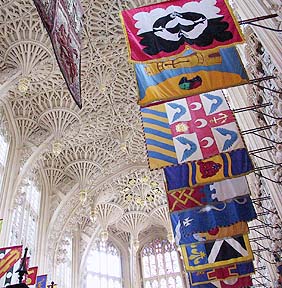
DAY 1 Walking tour of Piccadilly and Mayfair, Changing of the Guard, National Gallery, Trafalgar Square, Bus tour, Westminster Abbey (shown above), St. Paul's
Behind Eros is the Criterion Restaurant, one of the city's best, run by chef Marco Pierre White. With its Moorish-Byzantine décor, superb cuisine and excellent service, it demonstrates how far London has progressed on the culinary trail and how much fun you'll have eating in this gourmet capital.
Next door is the Criterion Theater, the only underground auditorium in town, and home to a long-running comedy troupe that alternates the Complete Works of William Shakespeare with the Complete History of America.
Piccadilly Circus is on the west edge of the theater district, with about 40 plays going on at a time in the six-block West End neighborhood. There are 100 smaller venues around town with fringe theater and cabaret revues. If you hope to see one of the smash hits, call six months ahead for reservations.
It is sometimes possible to get tickets to a sold-out show. Checking with your hotel desk or a ticket agency may uncover tickets for a 50-percent mark-up. You could also buy from scalpers who stand in front of every sold-out show, but their seats may be way up in the balcony. One trick is to stroll by a desired show a minute before curtain time, when scalpers may be desperate to dump their tickets.
Regent Street and Mayfair: This two-hour walking route takes you to the 11 a.m. Changing of the Guard ceremony at Buckingham Palace, which occurs daily, May through July, and every other day the remainder of the year, except when it rains.
From Piccadilly, walk along Regent Street, a majestic promenade, offering an urban vista particularly impressive when you stop after three blocks and look back from Vigo Street.
The oval building across Regent Street is the flagship of Aquascutum, an elegant clothing store. Garrard, jewelers to the crown, is adjacent, as is Austin Reed, another major clothing store. A string of major retailers continues for nine blocks, including Europe's largest toy store, Hamleys, and the designer department store Liberty.
This famous stretch was designed at the beginning of the 19th century by John Nash, one of England's most important architects. Most of his original buildings were replaced, so much of the street's character was lost. Regent Street continues to Oxford Street, a busy thoroughfare for shopaholics eager to see nine more blocks of retail outlets. The rest of us will take a left on Vigo, which soon becomes Burlington Gardens.
Streets can change names every few blocks, and are occasionally labeled as Row, Garden, Court, Path, Yard, Field, Hill or Mews. Ye olde terminology is part of the ancient heritage of London, which was founded by Romans 2,000 years before automobiles gave birth to streets. The narrow ,twisted lanes are one reason you do not want to drive here. And, of course, the British drive on the "wrong" side. Drivers will only stop for you if you are in a crossing guarded by a blinking orange light, so be careful. There will be times when cutting across a street in the middle of a block can be faster and safer than using an intersection, where a car could hit you from four different directions.
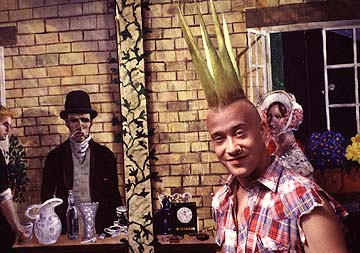
DENNIS CALLAN / SPECIAL TO THE STAR-BULLETIN
Punks with spiked hair can still be seen around town.
Bond Street: Start here at 9 a.m. Burlington Gardens is just three blocks long, with Saville Row, famous for custom tailoring, and Burlington Arcade, a covered shopping passage. Old Bond Street leads into expensive shopping turf. Note the fine sculptural details in the terra cotta on many of the facades. Like most of London, the buildings here are old and just six floors high.
The exclusive shops on Old Bond include Tiffany, David Morris, Bulgari, Patek Philippe, Georg Jensen and Asprey. Walk on to the less lofty stretch called New Bond Street, past the funny statue of Churchill and FDR sitting on a wooden bench. There are more beautiful shops for clothing, shoes, jewels and designer goods all the way to Oxford Street.
Oxford Street is the busiest shopping boulevard for locals, at a mile long and loaded with 60 shoe stores, clothing outlets, the huge department store Selfridges, record shops, jewelers, sporting goods stores and more.
To Berkeley Square: From Bond Street, take a left on Oxford and walk to Davies Street. Notice the Hog in Pound pub on the corner, one of the busier watering holes in town. Davies has a peaceful residential character, with few shops and quaint side streets called "Mews," formerly lined with horse stables that have been transformed into exclusive townhouses.
If you want to see Grosvenor Square and the American Embassy, detour right on Brook Street for a block, deeper into Mayfair; otherwise stay on Davies. You will reach a patch of greenery called Berkeley Square. Rest on a comfortable bench in the cool shade of the giant plane trees and watch squirrels.
Exit the park on the southeast end, go three blocks over to Bond Street via the Royal Arcade, and continue to the Burlington Arcade. Along the way you will pass Brown's Hotel, one of the swankiest settings for afternoon tea.
The Burlington Arcade is one block long and has 40 small shops with exquisite, expensive merchandise. London's covered 19th-century malls were copied from the Parisian glass-covered passages. Don't run, chew gum or make loud noises, lest you be stopped by the beadle, a traditional uniformed security gentleman on duty to maintain a proper sense of decorum.
Emerging on Piccadilly, turn left and pass the Royal Academy, peering into the courtyard for a look at how the aristocracy lived 200 years ago. It is now a major art museum.
Cross to Fortnum and Mason, a gourmet store founded 300 years ago. The atmosphere is elegant, with crystal chandeliers, mahogany counters and tuxedoed clerks. The ground floor is stocked with teas, caviar, pastries, meats, biscuits, wines, produce, pasta, chocolates, soups, condiments, jams, and more. Stop to buy omiyage for those at home, then have tea and a strawberry tart in the Fountain Restaurant. You are now ready for the palace guards, just five blocks away.
St. James: Behind Fortnum and Mason is Jermyn Street, with a couple of aromatic interiors worthy of a sniff. Floris has soaps and perfumes, and Paxton and Whitfields offers 300 kinds of cheese.
Look into St. James, one of Christopher Wren's magnificent parish churches. The church has a market and café out front.
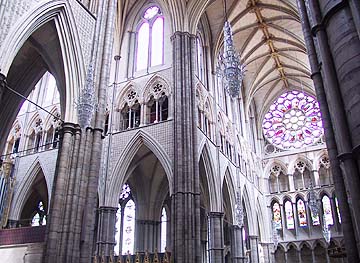
DENNIS CALLAN / SPECIAL TO THE STAR-BULLETIN
Westminster Abbey is a magnificent Gothic church begun by Edward the Confessor in 1050, with significant expansion in the 13th century.
Walk a block down Duke of York Street to St. James Square, a small park with lawns, flower beds, benches and trees. Pass through and continue to Pall Mall, a fancy street lined with gentlemen's clubs. This will lead you to St. James Palace and the first phase of the Changing of the Guard.
Changing of the Guard: The pomp and circumstance of this ritual is great fun, with the redcoat soldiers in their tall black hats parading to the bouncy rhythm of a marching brass band. Get to St. James Palace at 11:10 a.m. and wait along the curb on Marlborough Road for the first phase. In a few minutes, the guards will emerge with a small band and assemble in the courtyard of the Tudor-style palace, currently home to Prince Charles and home to English monarchs for 300 years, starting with Henry XIII, until Buckingham Palace replaced it in 1837.
The soldiers and band will pass quickly, so have your camera ready. Catch the next phase by walking across St. James Park and crossing the footbridge over the lake. Turn right and follow the path, looking for swans, pelicans, ducks and squirrels. Head toward the corner exit at Birdcage Walk and the Wellington Barracks, where the main troops and marching band are assembling.
Walk around the corner, heading toward Buckingham Palace. In a few minutes the troops will march by in all their glory, then disappear behind the palace gates. You can also catch the mounted guards if you walk along the path behind the flower beds to The Mall, where you get a perfect view of Buckingham Palace. In a couple of minutes the soldiers will ride by on their big black horses.
Trafalgar Square: Walk through St. James Park to Trafalgar Square, a landmark surrounded by majestic buildings, with Lord Nelson towering above on his soaring column. You'll see the church spire of St-Martin-in-the-Fields. There is a café in the basement, and free concerts in the church Mondays, Tuesdays and Fridays.
The National Gallery, one the world's great art museums, is on Trafalgar Square. Admission is free. The museum has a complete collection of all the important European painters, from the Gothic through Impressionism, displayed in beautiful galleries. This art museum ranks in the world's top four, along with the Louvre, Hermitage and New York's Met.
Westminster Abbey and St. Paul's: In front of the National Gallery is a great place to catch a tour bus, which will enable you to relax for two hours as the sights glide by. Several companies offer tours with open-top, double-decker buses winding through town, offering a nice overview of landmarks.
Hop off and on as sites catch your interest. Tours will take you by the Houses of Parliament and Big Ben, through the West End, across Tower Bridge and into the financial center. Especially worth seeing are Westminster Abbey and St. Paul's Cathedral, two of the grandest structures ever built.
Westminster Abbey is one of the finest Gothic churches in the world. Edward the Confessor began the building around 1050 and large-scale expansion commenced in 1245, with major additions made during the next 500 years.
St. Paul's Cathedral was built by the great Christopher Wren between 1675 and 1708 in the Baroque style, with many Renaissance influences.
The Abbey is open until 5 p.m., while St. Paul's closes at 4 p.m. and reopens at 5 p.m. for the free "evensong" service, with a choir singing heavenly music. Admission to each church is about $7.
Tower of London, British Museum, Soho, Covent Garden, Leicester Square
Take the Tube: The underground rail service is the quickest way to travel from one part of town to another. A single ride costs $2.25, or you can buy a one-day $7 Travelcard, good for unlimited travel in the central zone, but not valid in the rush hour before 9:30 a.m. The Travelcard can be purchased at any tube station.
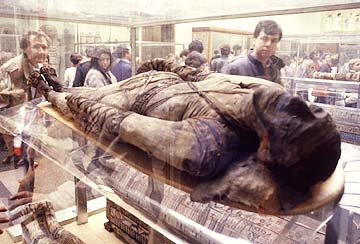
DAY 2 Tower of London, British Museum (shown above), Soho, Covent Garden, Leicester Square
Tower of London: Ride the tube to this huge castle on the Thames, the oldest building in London, dating to 1078, when William the Conqueror began its construction. Costumed guides give presentations about life in old England.
The Yeoman Warders (or "Beefeaters") are the most famous Tower guides, with their Elizabethan costumes and fascinating stories about the history of torture, imprisonment, ghosts and intrigue surrounding this royal fortress. Follow them on a one-hour tour. Presentations by other guides in period costumes are also entertaining, with demonstrations of household utensils, tools and artifacts.
The Crown Jewels are the main attraction. Get to the Jewel House before lines start forming and enjoy the video presentations in the two lobbies. The jewels display room is well-designed, with moving sidewalks on both sides of the cases. The world's largest diamond, the Cullinan stone, is in the royal scepter.
The White Tower is the oldest building of the castle and has a spectacular new multi-level display featuring suits of armor and historic weapons. The Tower Green was the site of many executions, including that of Anne Boleyn, who was beheaded for her inability to have a male child, even though she did give birth to the great monarch, Elizabeth I.
Walk along the outer wall for nice views of Tower Bridge and the castle complex. Continue to the British Museum, via tube, changing trains at Liverpool Station. On Sundays, consider a detour to the mile-long street market at Petticoat Lane, two blocks from the station. London's other famous street market happens Saturdays at Portobello Road in Notting Hill, with more of an emphasis on antiques.
British Museum: Stay on the tube to Holbron and stroll through Bloomsbury, an intellectual neighborhood that is home to the University of London and the British Museum. Emerging from the tube, bear right on New Oxford Street as it forks from High Holbron, and turn right on Museum Street for a two-block stretch of bookstores and old-fashioned shops. The Museum Tavern serves a delicious hot buffet lunch, or try Wagamama, a popular Asian noodle restaurant a block west.
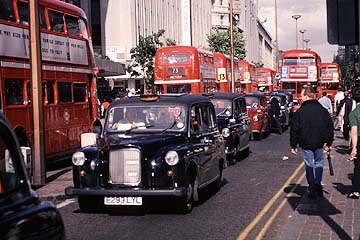
DENNIS CALLAN / SPECIAL TO THE STAR-BULLETIN
Double-decker buses crowd Oxford Street, London's busiest shopping street for locals. Oxford Street is one mile long and loaded with 60 shoe stores, clothing outlets, jewelers, sporting goods stores and the huge Selfridges department store.
The British Museum opened in 1759. The ancient Greek and Egyptian collections are the main treasures, especially the Elgin Marble statues from the Parthenon in Athens, several mummies, statues and jewelry from ancient Egypt. You will also find displays about the Romans in Britain, ancient Assyrians, Celtic prehistoric life, and the Middle Ages. The museum is open daily from 10 a.m. until 5:30 p.m., and till 8:30 p.m. on Thursdays and Fridays. Admission is free.
Some lively neighborhoods: After the museum you will be back on the Central London streets. Electronic gadget fans can find all the latest "toys" on three blocks of Tottenham Court, while those looking for shoes or clothing might have a go on Oxford Street. Head south to where Tottenham Court becomes Charing Cross Road, a famous literary street with many bookshops, including Foyles, the largest in town. This street leads into London's most interesting neighborhoods -- Soho, Covent Garden and Leicester Square -- which stay lively all night.
Just 1/4 mile south, you will arrive at the Cambridge Circus intersection. Plunge into Soho by walking down Old Compton Street, and the fascinating side streets Greek, Frith and Dean, where people come to party.
Chinatown: Cross over the busy theater street, Shaftsbury Avenue, and walk a block to the center of Chinatown. It's just four square blocks, with about 40 Chinese restaurants. Greater London has several Asian neighborhoods, but this original Chinatown is still the busiest of all. A block south is Leicester Square.
Leicester Square: This is the one of the most exciting centers of London, with mobs of people, surrounded by huge movie complexes and mediocre restaurants. The action picks up in the afternoon and carries on until midnight, with street performers (buskers) to keep you entertained.
Moon Under Water is a friendly pub on the square. There is an excellent wine cellar restaurant on one of the side alleys. Cork and Bottle offers a large selection of wines by the glass in a cozy, friendly setting.
The sure thing for theater discounts is found at the half price "tkts" booth. You can usually get good $25 seats for half the shows in town. A warning: There are some fraudulent storefront operations with signs that proclaim "Half Price Tickets." Look for the free-standing clock tower building in the square for the real deal.
Exit the square in the direction of the tube station next to the Hippodrome club. Now you are heading for Covent Garden.
Covent Garden: You can walk from Leicester Square along Long Acre, passing the Stanford, the world's largest travel bookstore, reaching the Covent Garden tube station, then taking a right down James Street. More fun is to go via the little pedestrian alleys that lead to the Piazza. These shop-filled passageways are so quaint you'll feel like you slipped back a few centuries. Salisbury Pub, Brown's and Giovanni's Italian Restaurant are three of the best eateries in this neighborhood.
There is no garden at Covent Garden, but you will find unique shops, restaurants, sidewalk entertainment and marvelous buildings. In the heart of it all is Central Market, where Eliza Doolittle sold flowers in "My Fair Lady." The area was once London's main food market, but this disappeared in 1974 when the shops came in, transforming this area into a daily street festival. You can usually find sidewalk entertainers in front of St. Paul's Church, the neoclassical creation of Inigo Jones, who designed the piazza in the Italian style back in 1631.
Covent Garden became a cultural center with the opening of the Theater Royal in 1663 and Royal Opera in 1732. Both theaters still operate, with the latest northeast colonnade just completed. Performances from the opera's stage are projected on a giant outdoor video screen in the piazza on many summer evenings.
The covered market building in the center is a grand 19th century structure in the early industrial style. Classical string quartet performances by London College of Music students often take place in the outdoor lower level of the South Hall, or maybe you'll catch a Chinese ensemble on James Street near the tube station.
Rules, London's oldest restaurant founded in 1798, a block away on Maiden Lane, still serves traditional English food. Another attraction is the London Transport Museum, with old buses, cars, bicycles and rail cars. Or have a French meal at Chez Gerard, or excellent Italian at Bertorelli's. Wander toward The Strand and drop in at the elegant Savoy Hotel for tea, then continue to Waterloo Bridge for the best views along the Thames. Art lovers might continue another block to the Cortauld Institute to admire its fine Impressionist collection.
Tube to South Kensington, Victoria & Albert and Natural History Museums, Harrods, South Bank
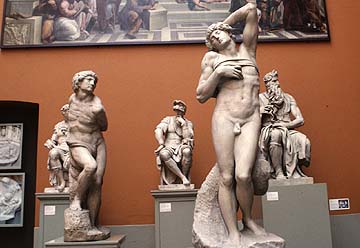
DAY 3 Tube to South Kensington, Victoria & Albert and Natural History Museums (shown above), Harrods, South Bank
You have seen most of the city's main attractions, but there are more fascinating museums, and Harrods. Take the tube to South Kensington and visit the two big museums, the Natural History and the Victoria and Albert.
The museums are one block from the village center. They open at 10 a.m., and admission is free.
The Victoria and Albert is the world's largest decorative arts museum, with 4.5 million objects in 170 galleries spread over 12 acres on six levels, with seven miles of corridors. There are rooms featuring sculpture, furniture, clothing, musical instruments, jewelry, tapestries, paintings, silver, porcelain and photography.
Walk next door to the Natural History Museum, which is filled with taxidermy, bugs, dinosaurs, plants, metal ores, gemstones, and other displays that tell the story of nature. It is worth going here just to see the soaring brick lobby, 100 feet wide and 170 feet long with dinosaur models 85 feet long. Behind it is the Science Museum that focuses on technology, with hands-on exhibits for kids.
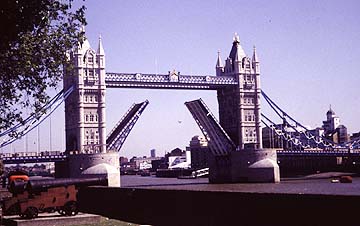
DENNIS CALLAN / SPECIAL TO THE STAR-BULLETIN
Tower Bridge, a drawbridge that opens to let tall ships pass, is near the Tower of London, a huge castle on the Thames that is the oldest building in the city.
Harrods: The next major goal is Harrods, which is just 1/2 mile along Brompton Road. Harrods has 22 restaurants. For the ultimate splurge, indulge in the $48 Georgian Restaurant buffet that's fit for a king. The flamboyant store owner, Mohamed Al Fayed, inspects the spread daily.
Paradise for shoppers, this store has 300 departments coverings 20 acres on seven levels. The sales clerks are experts in their areas. Be sure to see the elaborate temple motif of the Egyptian Hall on the ground floor, which leads directly into the Food Halls, where you can purchase teas, jams, cookies and chocolates that say Harrods.
There could be extended shopping thrills along Brompton Road, with its many boutiques, leading to another big high-quality department store, Harvey Nichols. The Nichols cocktail lounge is yuppie central.
South Bank: One major neighborhood beckons the art lover. Dubbed the South Bank, on the south side of the Thames, it has several major attractions: the Tate Modern with an excellent 20th century art collection; the Globe Theater; and the Eye of London, the world's largest Ferris wheel. This "left bank" has been a cultural center for many years, with concerts, events and exhibits offered at the Royal Festival Hall, Hayward Gallery, Royal National Theater, Bankside Gallery and other attractions like Oxo Tower, London Aquarium and Vinopolis.
That covers all the important angles for three days in London, though you could easily spend another week. You could also take day trips to Hampton Court, Windsor, Greenwich, Stonehenge, Bath or Cambridge.
Ask your hotel to arrange a bus tour, or catch a train. It's even possible to take the two-hour fast train to York, a medieval walled town in the north, to continue exploring the rest of England.
BACK TO TOP
|
Here are places to stay, eat and visit in London. The prefix for the phone and fax numbers from the United States is 011-44-207. IF YOU GO
HOTELS
>> Berkshire: 350 Oxford St. Phone 629-7474, fax 629-8156.
>> Comfort Inn Kensington: 22-32 W. Cromwell Road. Phone 373-3300, fax 835-2040.
>> Mountbatten: 20 Monmouth St. Phone 836-4300, fax 240-3540.
>> Thistle Trafalgar Square (my favorite): Whitcomb Street. Phone 930-4477, fax 925-2149.
>> Westbury: Bond Street. Phone 629-7755, fax 495-1163.
RESTAURANTS
>> Criterion Brasserie: 224 Piccadilly. Marco Pierre White's "grand dame" of dining boasts awesome French-Med cooking; 0207-930 0488.
>> Food for Thought: 31 Neal St. Informal basement vegetarian restaurant, my favorite, serves delicious wholesome food; 0207-836 9072.
>> L'Escargot: 48 Greek St. Classic French menu, "one of London's best"; 0207-437 6828.
>> Mezzo: 100 Wardour St. Modern European fare in a "buzzing" ambience; 0207-314 4000.
>> Rules: 35 Maiden Lane. This unique bastion of British cuisine is London's oldest restaurant, circa 1798; 0207-836 5314.
>> The Ivy: 1 West St. No. 1 in popularity, with a modern British-European menu; 0207-836 4751.
>> Wagamama: 10-A Lexington St. Japanese noodle bar epitomizes efficient minimalism; 0207-292 0990.
ATTRACTIONS
>> British Airways London Eye Jubilee Gardens, South Bank, 10 a.m. to 10 p.m. May to August; costs $14.
>> British Museum, Great Russell Street. Open 10 a.m. to 5 p.m. Mondays to Wednesdays, Saturdays and Sundays, and 10 a.m. to 8 p.m. Thursdays and Fridays. Free.
>> Courtauld Gallyer Courtauld Institute of Art, Somerset House. Daily 10 a.m. to 6 p.m. $7.50 admission, free under 18; free 10 a.m. to 2 p.m. Mondays.
>> Hampton Court Palace East Molesey. Open 10:15 a.m. to 6 p.m. Mondays, 9:30 a.m. to 6 p.m. Tuesdays to Sundays in summer. Closes at 4:30 p.m. daily in winter.
>> National Gallery, Trafalgar Square. Open 10 a.m. to 6 p.m. Thursdays to Tuesdays and 10 a.m. to 9 p.m. Wednesdays.Free.
>> Natural History Museum, Cromwell Road. Open 10 a.m. to 5 p.m. Mondays to Saturdays and 11 a.m. to 5 p.m. Sundays. Free.
>> Royal Academy of Arts Burlington House, Piccadilly. Open 10 a.m. to 6 p.m. Saturdays to Thursdays and 10 a.m. to 10 p.m. Fridays.
>> Shakespeare's Globe Theatre and Exhibition New Globe Walk, Bankside. Theater performances and tours 9 a.m. to noon daily May to September; 10 a.m. to 5 p.m. daily from October to April.
>> St. Paul's Cathedral, The Chapter House, St. Paul's Churchyard. Open 8:30 a.m. to 4 p.m. Mondays to Saturdays, with Evensong at 5 p.m.
>> Tate Modern, Bankside Power Station. Open 10 a.m. to 6 p.m. Sundays to Thursdays and 10 a.m. to 10 p.m. Fridays and Saturdays. Free.
>> Tower of London, Tower Hill. Open 9 a.m. to 5 p.m. Mondays to Saturdays and 10 a.m. to 5 p.m. Sundays from March to October, and 9 a.m. to 4 p.m. Tuesdays to Saturdays from November to February.
>> Victoria & Albert Museum, Cromwell Road. Open 10 a.m. to 5:45 p.m. Thursdays to Tuesdays and 10 a.m. to 10 p.m. Wednesdays. Free.
>> Westminster Abbey: Open 8:30 a.m. to 5 p.m. Mondays to Saturdays. Evensong with singing choir at 5 p.m.
Dennis Callan is the president of the Hawaii Geographic Society and produces the "World Traveler" television series, shown at 7 p.m. Tuesdays, repeating 9 a.m. Wednesdays on 'Olelo, channel 52. He frequently leads tours through Europe, and writes "Three Days In ..." the first Sunday of each month explaining how to get the most out of three days in the world's great places. View the companion TV episode this week.